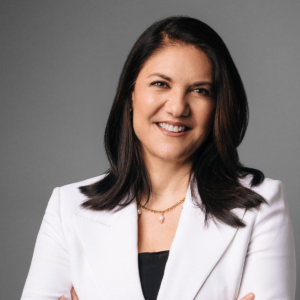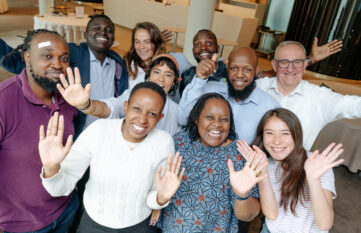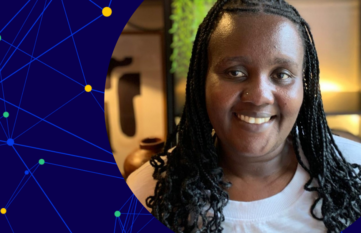“The most important thing is to listen to the women themselves” – an interview with Mary Ellen Iskenderian, Women’s World Banking

Financial inclusion can improve the lives of women worldwide, Mary Ellen Iskenderian of Women’s World Banking is convinced. The president and CEO of the nonprofit organization calls on financial service providers, governments, but also every individual to rethink.
Nearly one billion women worldwide don’t have access to financial services – why is this a problem?
That’s a good question because many of us take it for granted that women have access to financial services. But the reality is different. At Women’s World Banking, we believe that financial inclusion is not necessarily an end in itself. We now know that 13 of the 17 UN Sustainable Development Goals are dependent on the achievement of financial inclusion. And given that women are disproportionately excluded, women’s financial inclusion is essential.
To what extent does financial inclusion improve women’s lives?
We know without a doubt that when a woman has greater control over the financial resources that she is generating or that are coming into the household, she has a louder voice and a more decisive role in household decision making. There is also very compelling data that indicates that women not only vote more when they have access to capital and financial services, but they are also more likely to stand for office themselves. Women also seem more able to get themselves out of abusive relationships if they know they have access to economic and financial resources that don’t force them back into that relationship. At Women’s World Banking, we track all of our projects across the range of changes a woman goes through when she has access to and control over financial resources. Most obvious are the material changes in her life. Her relationships with others in her household and community also transform, as does her perception of herself. And then there is the cognitive change. Does a woman become more aware of her options, opportunities and activities when she opens a savings account or applies for a loan, for example? However, it’s no longer enough to just be financially literate and understand finance. But you also need to understand that digital technologies as well.
Is digital technology the silver bullet to close the gender gap in financial inclusion?
Digital technologies have the potential to be a silver bullet. The one thing we just absolutely have to be single-minded about right now is getting technology into the women’s hands. There’s a lot of data that shows that when technology is available to them, and they’re trained and empowered, women are more willing than men to choose a digital financial service. But they have to gain that initial access. We still have a gender gap of up to 18 percent in smartphone ownership. That’s a big barrier to women’s financial inclusion. Many financial service providers are designing products for Internet enabled technologies. So without that technology, women are just cut off right at the start. Only when we have greater parity in access, digital technology can unleash their power as a silver bullet to close the gender gap.

Digital technologies have the potential to be a silver bullet. […] There’s a lot of data that shows that when technology is available to them, and they’re trained and empowered, women are more willing than men to choose a digital financial service. But they have to gain that initial access. […] Only when we have greater parity in access, digital technology can unleash their power as a silver bullet to close the gender gap.
Mary Ellen Iskenderian, CEO Women’s World Banking
What prevents women from bridging the digital gender gap?
There are so many different cultures, people and social norms around the world. The fascinating thing is that we still find that the barriers to woman’s financial access are very similar across countries. We of grouped these barriers in three ways. One is the barriers experienced by the woman herself. She is less aware of her options and less confident about both her digital and financial literacy. The second group are the barriers put up by financial service providers themselves. We know that despite loads of evidence to the contrary, they are still unconvinced that women represent a lucrative, valuable and loyal customer base. This is partly because there is still a shocking lack of gender disaggregated data. In many countries, banks and other financial service providers are still not required to report their data as it’s broken down between genders. So we don’t really have an overview of whether or not a product is being used by men or by women which only serves to reinforce inequality of access. The third set of barriers are regulatory or policy based.
So it’s the governments’ turn?
Governments could, for example, mandate the collection of gender disaggregated data or even revise collateral requirements for banks. We know that the biggest barrier to women entrepreneurs gaining access to productive credit is a lack of collateral. When the International Monetary Fund declared a few years ago that financial inclusion was macro-critical and had an important macroeconomic impact, that was an important step. One of their findings was that inequality in an economy or in the way that economy grows is exacerbated unless special efforts are made to reach the most excluded. Even with the best of intentions, inequality will only increase if you don’t take care of those who are most excluded. And in any economy, women are always among the most excluded.
Can digital technologies also help women and female entrepreneurs overcome restrictive social norms?
Yes, very much so. We’re excited about the possibilities that digital technology offers to overcome barriers of mobility. We know that even women who use technology tend to do business within a much smaller radius of where they live than men. So it’s exciting to see a growing number of women accessing e-commerce platforms. They may be staying at home and may not have expanded their physical mobility, but their business may be able to transcend those limits of mobility. When we talk about social norms and digital, it’s also important to talk about some of the difficulties women face in gaining access to the technology for social reasons. The Global Mobile Suppliers Association (GSMA) reports that when they ask women around the world why don’t you have an Internet enabled phone or why aren’t you more active on the Internet, women from countries with more restrictive social norms often report that their family would disapprove. The COVID pandemic had very, very few positive impacts on women, but we could see some of those social barriers being broken down in the face of a pandemic that really drove a contactless economy. We saw, for the first time, a dramatic lowering of the gap in cell phone ownership.
What is the role of Digital Public Infrastructure, such as e-identification or e-payments, for women’s economic empowerment through financial inclusion?
A very, very important one. I would almost want to flip the question a little bit, because I think policymakers and people who are engaging in public infrastructure don’t necessarily recognize that there are gender implications for something, like infrastructure, that they consider to be gender neutral. The digital ID is closely related to the same billion women who don’t have access to financial services. There are also about a billion women who don’t have access to a digital ID. Yet this ID is fundamental to joining the formal financial system in many countries around the world. Women’s ID is in the legal system very tied up to marriage laws, birth, customs, family, and family law. We really need to separate those two things so that women are able to gain access to that digital ID which is crucial for financial inclusion.
For what else?
More and more governments are moving their programs, including benefits transfers, online. We saw that very clearly during the COVID pandemic, where so many more women-owned businesses could have benefited from the relief that was made available by governments for small businesses. But because they weren’t registered and operated in the informal sector, governments couldn’t even find them. There are other elements of digital infrastructure that have very strong gender implications as well. For example, let’s make sure that all the different private sector public payment systems are now, interoperable, and can work together with the public system. People can’t carry around different PIN cards, different SIM cards to make pqyments through different platforms.
The German government recently adopted a feminist development policy. What do you say to that?
Well, I would say brava! That’s very exciting. Germany is joining a growing number of countries that are making the decision to formulate a feminist foreign policy. If the German experience is anything like what we’re seeing in other countries, there could be a real increase in resources dedicated to gender inequality. We’ve seen a more coordinated, whole-of-government approach to gender equality, not just individual agencies working on an ad hoc basis. The public in Germany seems to be becoming more aware of the importance of gender equality and the importance of focusing on gender. So I’m very optimistic and hopeful about what might emerge from this decision by the German government.
What area should be the focus of feminist foreign policy?
I am so involved in issues of economic empowerment and believe so strongly that if a woman is economically empowered, she can achieve so many other goals: Better housing, better education, better health care for her family. We know that when government relief payments and assistance programs are targeted specifically to women and not just the head of household, more people in the family benefit. We see better outcomes in terms of better nutrition and better health. More of the children, both girls and boys, tend to stay in school. So if I had to put my chips on one area, I would say really make sure that the economic element of gender equality has a large focus.

I […] believe so strongly that if a woman is economically empowered, she can achieve so many other goals: Better housing, better education, better health care for her family. […] So if I had to put my chips on one area, I would say really make sure that the economic element of gender equality has a large focus.
Mary Ellen Iskenderian, CEO Women’s World Banking
Women’s World Banking is promoting women’s economic empowerment for 40 years. What are the lessons learned from the past 40 years?
The most important thing is to listen to the women themselves. Ask them what they want. And then listen. Don’t assume that what works in one country will necessarily work in another. Don’t assume that what works for men is going to necessarily work for women. Even if solutions may be broadly similar, the way they are delivered, marketed or explained may differ. We know that women learn best from other women. There is quite a bit of data about the value peer learning. So I think just listening to what women want, how they want to receive the information, product or service, is the most important thing we can all do.
Women’s World Banking has been working with KfW and BMZ for many years to mobilize private capital. Can you tell us more about this partnership?
KfW was one of the earliest believers in Women’s World Banking as an impact investor. About a dozen years ago, we felt that as an organization, we needed to not only advise, but also invest and try to drive change in companies to have the greatest impact possible. So we were honored that KfW was one of the largest investors in our first WWB Capital Partners fund. In our second fund, KfW and BMZ came together.They invested equity in this second fund and provided a first loss provision. So we were able to mobilize private sector capital and also attract reluctant investors who see investing in women in developing countries as very risky. It also brought us as investors into slightly riskier countries and to companies that are at a slightly earlier stage in their development. So it was not only a mobilizer of capital, but it allowed us to take well considered but greater risks.
There is a second reason why the partnership with the BMZ has been so impactful. They were contributor to a technical assistance facility that allowed us to do two things: We assess whether the company we are investing in is doing all it can internally to promote gender diversity. Are they making sure that women are reflected up and down at the board level all the way to the working level of the organization? Do they also support women externally in their market? We, together with the company, design a gender action plan and then hold each other accountable. None of that would have been possible without this technical assistance facility.
You recently published a book – what message does it carry for actors in the financial sector, for KfW and the BMZ?
The book title is “There is nothing micro about a billion women” which carries the message that there is a lot more than microfinance that women need in order to be fully empowered and full economic and financial citizens. The other main message of the book is that there is something literally everyone can do to further women’s financial inclusion. Policymakers can make sure that there is a level playing field in their country. Financial services providers can get rid of the outmoded view that there isn’t a strong business case for serving women. Investors can hold companies truly accountable for gender equity and diversity in their organizations. Even in our own investment portfolio, there is evidence that institutions that have greater gender diversity, that have more women on the front lines, are more likely to serve female clients. So before you take out an insurance policy or take out a housing loan, take a look at what the gender diversity of your bank or insurance company is like. We can all be a lot more deliberate about the choices we make as consumers of financial services.

Mary Ellen Iskenderian
About
Mary Ellen Iskenderian is President and CEO of Women’s World Banking, a global nonprofit organization whose mission is to provide access to financial tools and resources for low-income women in developing countries. She joined Women’s World Banking in 2006 and leads the Women’s World Banking Global Team based in New York. She is also a member of the Investment Committee of WWB Capital Partners Funds I and II. Prior to joining Women’s World Banking, Mary Ellen worked for 17 years at the International Finance Corporation, the private sector arm of the World Bank. She had previously worked for the investment bank Lehman Brothers. Mary Ellen is a permanent member of the Council on Foreign Relations, as well as a member of the Women’s Forum of New York. She serves as a Director on the Board of the William and Flora Hewlett Foundation. She was recognized in the Forbes “50 over 50: Investment” list, which highlights female investors and financial leaders. Her first book, “There’s Nothing Micro About a Billion Women: Making Finance Work for Women”, was published by MIT Press in April 2022.


